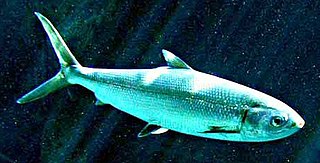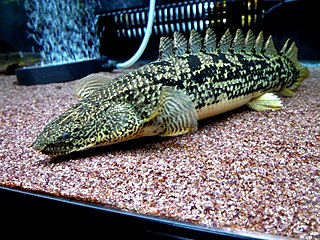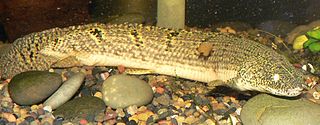
Actinopterygii, members of which are known as ray-finned fish or actinopterygians, is a class of bony fish that comprise over 50% of living vertebrate species. They are so called because of their lightly built fins made of webbings of skin supported by radially extended thin bony spines called lepidotrichia, as opposed to the bulkier, fleshy lobed fins of the sister class Sarcopterygii. Resembling folding fans, the actinopterygian fins can easily change shape and wetted area, providing superior thrust-to-weight ratios per movement compared to sarcopterygian and chondrichthyian fins. The fin rays attach directly to the proximal or basal skeletal elements, the radials, which represent the articulation between these fins and the internal skeleton.

The Gonorynchiformes are an order of ray-finned fish that includes the important food source, the milkfish, and a number of lesser-known types, both marine and freshwater.

Bichirs and the reedfish comprise Polypteridae, a family of archaic ray-finned fishes and the only family in the order Polypteriformes.

Euteleostomi is a successful clade that includes more than 90% of the living species of vertebrates. Both its major subgroups are successful today: Actinopterygii includes most extant bony fish species, and Sarcopterygii includes the tetrapods.

Polypterus senegalus, the Senegal bichir, gray bichir or Cuvier's bichir, and sometimes called the "dinosaur eel", "dinosaur bichir", or "dragon fish" is in the pet trade due to its lungfish-like appearance, which was described as more primitive and prehistoric than other modern fishes. It is a prototypical species of fish in the genus Polypterus, meaning most of its features are held across the genus. It is commonly kept in captivity by hobbyists. They are native from Africa where they are the most widespread species of the genus.

Polypterus is a genus of freshwater fish in the bichir family (Polypteridae) of order Polypteriformes. The type species is the Nile bichir. Fish in this genus live in various areas in Africa. Polypterus is the only known vertebrate to have lungs, but no trachea.

Saurichthys is an extinct genus of predatory ray-finned fish from the Triassic Period. It is the type genus of the family Saurichthyidae, and the most speciose and longest lasting genus in the family. This family also includes the Permian Eosaurichthys (China) and the Jurassic Saurorhynchus from Europe and North America, though it may be more appropriate to treat these as subgenera of Saurichthys, due to the genus Saurichthys otherwise being paraphyletic.

The Palaeonisciformes, commonly known as "palaeoniscoids" are an extinct grouping of primitive ray-finned fish (Actinopterygii), spanning from the Silurian/Devonian to the Cretaceous. They are generally considered paraphyletic, but their exact relationships to living ray-finned fish are uncertain. While some and perhaps most palaeoniscoids likely belong to the stem-group of Actinopteryii, it has been suggested that some may belong to the crown group, with some of these possibly related to Cladistia and/or Chondrostei. Many palaeoniscoids share a conservative body shape and a similar arrangement of skull bones.

The barred bichir, armoured bichir, bandback bichir, or banded bichir is an elongated fish found in the Congo River, specifically in the upper and middle portions. This species is one of the more commonly available in commercial pet stores.
Scanilepis is an extinct genus of prehistoric bony fish that lived during the Rhaetian-?Hettangian ages. The type species, S. dubia, is known from the Rhaetian freshwater deposits of the Bjuv member of the Höganäs Formation, southwestern Sweden. A second species, S. spitzbergensis was mentioned from the Hettangian of the Festning section of the Grøfjorden area in Spitsbergen, Norway but was never described.
Boreolepis is an extinct genus of prehistoric bony fish that lived during the Wuchiapingian age in what is now Clavering Island, Greenland, and Vologda Oblast, Russia.

Prohalecites is an extinct genus of ray-finned fish from the Ladinian and possibly Carnian (Triassic) of Italy. It is the oldest known teleosteomorph, a group that includes extant teleosts and their close fossil relatives.

Saurichthyiformes is an extinct order of ray-finned fish which existed in Asia, Africa, Australia, Europe and North America, during the late Permian to early Middle Jurassic. Saurichthyiiformes comprise two families, Saurichthyidae and Yelangichthyidae. Yelangichthyidae is monotypic, containing only the genus Yelangichthys. The gar or needlefish-like Saurichthyidae is primarily known from the genus Saurichthys. Additionally, the subgenera SaurorhynchusCostasaurichthys, Eosaurichthys, Lepidosaurichthys, and Sinosaurichthys are frequently used to group species, and are sometimes considered separate genera. Species are known from both marine end freshwater deposits. They had their highest diversity during the Early and Middle Triassic. Their phylogenetic position is uncertain, while they have often been considered members of Chondrostei, and thus related to living sturgeons and paddlefish, phylogenetic analysis of well-preserved remains has considered this relationship equivocal. They may actually belong to the stem-group of Actinopterygii, and thus not closely related to any living group of ray-finned fish.

Polypterus palmas, also called the shortfin or marbled bichir, is a fish in the family Polypteridae found in freshwater environments throughout West Africa.
This list of fossil fishes described in 2014 is a list of new taxa of placoderms, fossil cartilaginous fishes and bony fishess of every kind that have been described during the year 2014, as well as other significant discoveries and events related to paleontology of fishes that occurred in the year 2014. The list only includes taxa at the level of genus or species.
Polypterus mokelembembe is a species of the fish genus Polypterus, found in the central basin of the Congo River. It was once considered a morph of the closely related Polypterus retropinnis, but was given species status in 2006 with a description that reclassified both fishes. Because of the recency of the species' description and the fact that P. mokelembembe is the paralectotype of P. retropinnis, they are often mistaken for one another in the aquarium trade.
Polypterus polli, Poll's bichir, is a species of bichir from the Malebo Pool and the lower and central basins of the Congo River. It was named in honor of Belgian ichthyologist Max Poll.

Parasemionotiformes is an extinct order of neopterygian ray-finned fish that existed globally during the Triassic period. It comprises the families Parasemionotidae and Promecosominidae. Many of the included genera are monotypic and most species lived during the Early Triassic epoch.

Acropholis is an extinct genus of prehistoric marine bony fish that lived during the Wuchiapingian age in what is now Greenland and Hesse (Germany).

Pygopterus is an extinct genus of prehistoric bony fish that lived during the Wuchiapingian to Olenekian ages in what is now England, Germany, Greenland and Svalbard (Spitsbergen). It is one of the few genera of ray-finned fish known to cross the Permian-Triassic boundary.
















